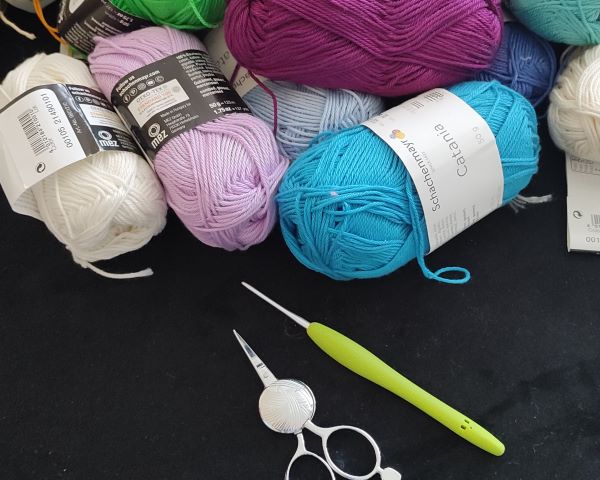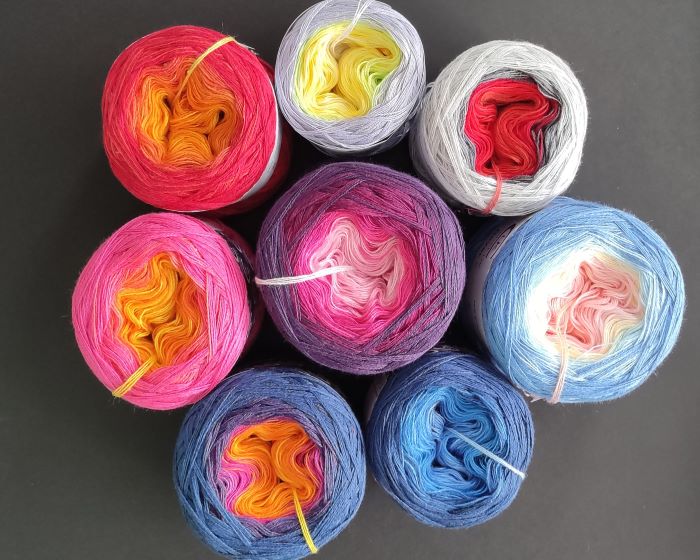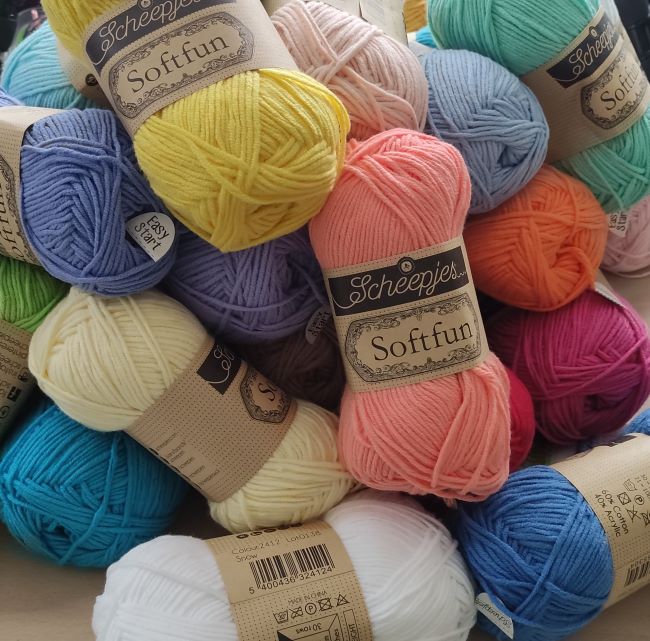
Have you ever picked up a crochet pattern and felt confused about which yarn to use? With so many different yarn weights available, choosing the right one can feel overwhelming. The thickness of your yarn not only impacts the look of your stitches but also affects the drape, durability, and overall feel of your finished project. Using the wrong weight can lead to frustration—maybe your sweater turns out too stiff, your blanket too thin, or your amigurumi too floppy.
Understanding yarn weights is key to creating projects that match your vision. Whether you’re making a delicate lace shawl, a cozy winter blanket, or a sturdy tote bag, knowing how different yarn weights behave will help you achieve the best results. In this guide, we’ll break down the different yarn weights, what they’re best used for, and tips for choosing the perfect yarn for your next crochet project. By the end, you’ll have the confidence to pick the right yarn every time!
What Are Yarn Weights?
Yarn weights range from super fine to super bulky, and each category serves different purposes in crochet. The Craft Yarn Council has established a standard system to categorize yarn weights, which makes it easier to choose the right one for your project.
How Yarn Weight Affects Hook Size & Stitch Definition
- The hook size you use greatly impacts the final texture of your project. A smaller hook creates tighter stitches, while a larger hook gives a looser, drapier fabric.
- Lighter-weight yarns like lace or fingering are perfect for intricate stitches, while heavier yarns like bulky or jumbo work well for simple stitches where texture and warmth matter more.
- Show an example of how a single stitch (e.g., double crochet) looks different depending on the yarn weight used.
How Yarn Weight Impacts Project Time & Yarn Usage
When planning a crochet project, the weight of your yarn plays a major role in determining how long it will take to complete and how much yarn you’ll need. Whether you’re working on a quick one-hour scarf or a detailed lace shawl, understanding how yarn thickness affects your project can help you make the best choice for your needs.
Thicker Yarns for Faster Projects
If you’re looking for quick and satisfying crochet projects, bulky (weight 5) and super bulky (weight 6) yarns are your best friends. Because thicker yarn creates larger stitches, you cover more surface area with fewer rows and less effort. This makes bulky yarn perfect for last-minute gifts, warm winter accessories, and cozy blankets. A chunky crochet cowl, for example, can be finished in just a couple of hours, while a worsted-weight version of the same pattern might take an entire weekend.
Thinner Yarns for Detailed, Intricate Work
On the other hand, if you love intricate stitches and delicate designs, you might prefer working with lighter-weight yarns like fingering (weight 1) or sport (weight 2). While these yarns take more time to crochet with since they require more stitches to fill the same space, they allow for beautiful stitch definition and fine details. This is why thinner yarns are often used for lace shawls, baby garments, and intricate doilies. The extra effort is worth it for projects that require elegance and precision.
How Yarn Weight Affects Yarn Usage
Another factor to keep in mind is that yarn weight impacts how much yarn you’ll need for a project. If you’re making a blanket, for example, using bulky yarn will require fewer yards compared to using sport-weight yarn. Even if both blankets end up the same size, the thinner yarn requires more stitches to cover the same area, meaning you’ll need more yarn overall. This is especially important when substituting yarns in a pattern—always check the yardage requirements rather than just relying on the number of skeins.
Yarn Weight & Fiber: Why It Matters
When choosing the perfect yarn for your crochet project, it’s important to consider both the weight and the fiber type, as different fibers behave uniquely at various thicknesses. The fiber you select can impact not just the texture and drape of your piece but also how it wears and feels over time.
Cotton
Cotton yarn is a favorite for summer garments and dishcloths due to its lightweight, breathable, and absorbent qualities. It has a crisp texture that holds its shape well, which makes it ideal for projects like beach bags or lightweight tops. However, heavier cotton yarns can become stiff and may not drape as nicely as other fibers, so it’s important to consider the weight when selecting cotton for your project.

Wool
Wool is renowned for its natural warmth, elasticity, and softness. It’s great for winter garments like hats, scarves, and sweaters. Wool’s stretchiness allows it to retain its shape, making it ideal for heavier weights such as worsted or bulky. These heavier wool yarns provide extra warmth and a cozy feel, making them perfect for cold-weather accessories and outerwear.
Acrylic
Acrylic yarn is versatile and budget-friendly, making it a go-to choice for many crocheters. It comes in a variety of weights, from lace to bulky, and offers great color variety. While acrylic is known for being durable and easy-care, the feel of the yarn can vary depending on its weight. Heavier acrylic yarns tend to be soft and squishy, while lighter acrylic yarns may feel a bit stiffer or more synthetic, which can affect the drape and overall comfort of the finished piece.
Alpaca
Alpaca yarn is prized for its luxurious softness and drapability. Lighter-weight alpaca yarns are perfect for projects like shawls and scarves, where you want a soft, flowing fabric that drapes beautifully. On the other hand, heavier alpaca yarns make incredibly warm and cozy sweaters or blankets, offering an extra layer of comfort without the itchiness some other fibers can cause. The natural drape of alpaca gives it a sophisticated look, especially in finer weights.
The 7 Standard Yarn Weights
1. Lace (0 – Super Fine)
- Best for: Delicate projects like doilies, lace shawls, and intricate patterns
- Crochet Hook Size: 1.6 mm – 2.25 mm (Steel hooks or B/1 in the US)
- Common Fibers: Cotton, silk, and fine wool
- Characteristics: Extremely thin and airy, perfect for lightweight, lacy designs
2. Super Fine (1 – Fingering, Sock, Baby)
- Best for: Baby garments, lightweight accessories, and delicate shawls
- Crochet Hook Size: 2.25 mm – 3.5 mm (B/1 to E/4)
- Common Fibers: Wool, cotton, bamboo
- Characteristics: Soft and lightweight, often used for socks and fine baby items
3. Fine (2 – Sport, Baby)
- Best for: Lightweight sweaters, baby clothes, and scarves
- Crochet Hook Size: 3.5 mm – 4.5 mm (E/4 to 7)
- Common Fibers: Cotton, alpaca, merino wool
- Characteristics: Slightly thicker than fingering yarn, offering warmth without bulk
4. Light (3 – DK, Light Worsted)
- Best for: Garments, amigurumi, light blankets, and accessories
- Crochet Hook Size: 4.5 mm – 5.5 mm (7 to I/9)
- Common Fibers: Cotton, acrylic, wool blends
- Characteristics: A versatile weight that works well for clothing and everyday accessories

5. Medium (4 – Worsted, Aran)
- Best for: Blankets, hats, scarves, and sweaters
- Crochet Hook Size: 5.5 mm – 6.5 mm (I/9 to K/10.5)
- Common Fibers: Acrylic, wool, cotton
- Characteristics: The most common yarn weight, offering a balance between warmth and durability
6. Bulky (5 – Chunky, Craft, Rug)
Characteristics: Works up quickly and provides a thick, cozy texture
Best for: Cozy blankets, thick scarves, and winter accessories
Crochet Hook Size: 6.5 mm – 9 mm (K/10.5 to M/13)
Common Fibers: Wool, acrylic, alpaca
7. Super Bulky (6 – Super Chunky, Roving)
- Best for: Quick projects like hats, blankets, and home décor
- Crochet Hook Size: 9 mm – 15 mm (M/13 to P/16)
- Common Fibers: Wool, acrylic, polyester
- Characteristics: Thick and warm, great for chunky knits and winter accessories
8. Jumbo (7 – Roving)
- Best for: Extreme knitting and crocheting, arm crochet, oversized blankets
- Crochet Hook Size: 15 mm+ (P/16 and up)
- Common Fibers: Wool, acrylic, fabric yarns
- Characteristics: Extremely thick, often used for statement pieces or fast projects
How to Choose the Right Yarn Weight for Your Project
When selecting a yarn weight, consider:
The project type: Delicate lace needs fine yarn, while a cozy blanket benefits from bulky yarn.
The stitch definition: Lighter yarns show intricate stitchwork better, while thicker yarns create a plush texture.
The drape and feel: Clothing should have a soft drape, so DK or worsted weight is often preferred.
Your patience level: Thicker yarns work up faster, great for quick projects!
Can You Substitute Yarn Weights?
Yes, but with caution! If a pattern calls for a certain weight and you want to substitute, keep these tips in mind:
Check the gauge: Always crochet a gauge swatch to make sure your stitches match the pattern’s instructions.
Adjust your hook size: If using a thicker yarn, go up a hook size; if using thinner yarn, go down a hook size.
Consider the project outcome: A heavier yarn might change the drape and size of your finished piece.
Special Considerations for Yarn Weight Substitutions
- If a pattern calls for DK-weight yarn but you only have worsted-weight yarn, you might need to adjust:
- Use a smaller hook for a tighter fabric.
- Adjust stitch counts to maintain the correct measurements.
- Be mindful that thicker yarn means a heavier finished project.
Choosing the right yarn weight is an essential step in creating beautiful and functional crochet projects. Whether you love the airy elegance of lace-weight yarn, the versatility of worsted-weight, or the cozy feel of super bulky yarn, each weight serves a unique purpose. By understanding how yarn weight affects stitch definition, drape, and warmth, you can make better decisions when selecting yarn for your projects.
If you’re ever unsure about which yarn weight to use, don’t be afraid to experiment! Crocheting a small swatch can help you determine if a particular yarn will work for your pattern. And if you need to substitute yarn, remember to check the gauge and adjust your hook size accordingly.
